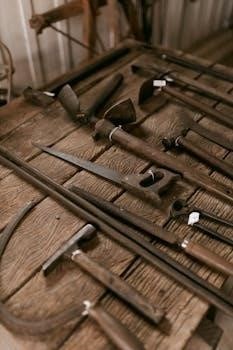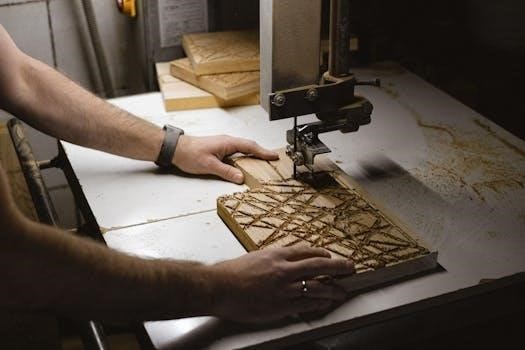Manual Saw⁚ A Comprehensive Guide

Manual saws, essential tools for woodworking and various cutting tasks, come in diverse types, each designed for specific applications․ From crosscut saws excelling in perpendicular cuts to rip cut saws ideal for lengthwise cuts, understanding their functionalities is crucial․ This guide explores manual saw varieties, components, and optimal usage․

Types of Manual Saws
Manual saws encompass a wide array of designs, each tailored for specific cutting tasks and materials․ Understanding these variations is key to selecting the right tool for the job․ The primary differentiation lies in the tooth configuration and blade design, influencing the saw’s efficiency in cutting along or across the wood grain․ Crosscut saws, designed for cutting perpendicular to the wood grain, feature teeth shaped like knives, severing wood fibers cleanly․ Rip cut saws, conversely, are optimized for cutting along the grain, employing chisel-like teeth to remove material efficiently․
Beyond these fundamental types, specialized saws cater to niche applications․ Coping saws, with their fine blades, excel in intricate curved cuts, while bow saws, featuring a blade stretched across a frame, are well-suited for outdoor tasks․ Panel saws, also known as hand saws, are versatile tools for general cutting purposes, and back saws, with a reinforced spine, offer precision and control․ This diverse selection ensures a manual saw exists for virtually any cutting need․
Crosscut Saws
Crosscut saws are specifically engineered for cutting wood perpendicular to the grain․ The teeth on a crosscut saw are shaped like knives, designed to sever the wood fibers as the saw is drawn across the surface․ This slicing action creates a clean and precise cut, minimizing splintering and tear-out․ The angle of the teeth, known as the rake angle, is typically steeper than that of a rip saw, further enhancing the cutting efficiency across the grain․
These saws are indispensable for tasks such as trimming boards to length, cutting tenon shoulders, and creating clean edges on panels․ The effectiveness of a crosscut saw depends on maintaining sharp teeth and applying consistent pressure during the cutting stroke․ A well-maintained crosscut saw is a valuable addition to any woodworking arsenal, ensuring accurate and professional-looking results when cutting against the grain․

Rip Cut Saws
Rip cut saws are designed explicitly for cutting wood along the grain, a task that requires a different tooth geometry than crosscutting․ Unlike the knife-like action of crosscut saw teeth, rip cut saw teeth resemble small chisels, each designed to remove a small shaving of wood with each stroke․ The teeth are set with a greater amount of “set,” meaning they are bent outward more, creating a wider kerf (the width of the cut) that prevents the blade from binding in the wood․
The rake angle of rip cut saw teeth is also different, typically closer to zero degrees, allowing for a more aggressive cutting action parallel to the wood fibers․ This design is essential for efficiently splitting the wood along its natural grain lines․ Rip cut saws are ideal for tasks like creating boards from logs or preparing stock for joinery․ Proper technique involves maintaining a consistent angle and applying steady pressure to guide the saw smoothly through the wood, resulting in a clean and accurate rip cut․
Universal Saws
Universal saws, as their name suggests, are designed to handle both crosscutting and ripping tasks, offering versatility for general woodworking․ These saws feature a tooth pattern that is a compromise between the aggressive chisel-like teeth of rip saws and the knife-like teeth of crosscut saws․ The tooth count is typically in the middle range, providing a balance between cutting speed and smoothness of the cut․
The tooth geometry of a universal saw includes a moderate rake angle and a slight set, allowing it to cut reasonably well both along and across the wood grain․ While not as efficient as specialized saws for either type of cut, universal saws are a practical choice for those who need a single saw for various projects․ These saws are often favored by hobbyists and DIY enthusiasts who appreciate their adaptability․ When using a universal saw, it’s important to maintain a steady pace and apply even pressure to achieve the best results, regardless of the cutting direction․ Proper technique ensures clean and accurate cuts in various wood types․
Components of a Manual Saw
A manual saw comprises several key components that work together to facilitate efficient cutting․ The primary component is the blade, typically made of hardened steel, which features a series of teeth designed to remove material as the saw is moved back and forth․ The shape, size, and set of these teeth determine the saw’s cutting performance for different materials and tasks․
The handle, usually crafted from wood or synthetic materials, provides a comfortable and secure grip, allowing the user to control the saw’s movement and apply the necessary force․ The handle’s design is crucial for reducing fatigue and enhancing accuracy․ The connection between the blade and the handle is often reinforced by fasteners such as rivets or screws, ensuring stability and preventing the blade from detaching during use․ Additionally, some saws feature a back or spine along the top edge of the blade, which adds rigidity and prevents bending, particularly in finer-toothed saws used for precise cuts․ Understanding these components is essential for selecting and maintaining the right saw for the job․
Hand Saw (Panel Saw)
The hand saw, also known as a panel saw, is a versatile and widely used manual saw designed for general-purpose cutting tasks in woodworking and construction․ Characterized by its long, broad blade and sturdy handle, the hand saw is primarily used for making cuts in wood, including both crosscuts and rip cuts, though its efficiency varies depending on the tooth configuration․
Typically, hand saws feature a blade length ranging from 20 to 26 inches, allowing for a substantial cutting depth and efficient material removal․ The teeth are usually arranged in a pattern optimized for either cutting across the grain (crosscut saws) or along the grain (rip saws), or a combination thereof in universal saws․ The handle, often made of wood or molded plastic, is ergonomically designed to provide a comfortable grip and enhance control during use․ Panel saws are valued for their portability and ease of use, making them indispensable tools for both professional carpenters and DIY enthusiasts․ Regular sharpening and proper maintenance ensure the saw’s longevity and optimal cutting performance․
Back Saw (Tenon Saw)
The back saw, often referred to as a tenon saw, is a specialized hand saw characterized by a thin blade reinforced with a metal spine along its back edge․ This spine provides rigidity to the blade, allowing for precise and controlled cuts, especially when creating joinery․ The term “tenon saw” specifically refers to back saws used for cutting tenons, a common woodworking joint․
Back saws typically have finer teeth compared to hand saws, making them ideal for detailed work and achieving smooth, clean cuts․ The blade length generally ranges from 10 to 16 inches, and the saw is designed to be used with a sawing motion that leverages the rigid back for accuracy․ These saws are particularly useful for tasks such as dovetailing, mitering, and cutting small pieces of wood where precision is paramount․ The back saw is a staple in any serious woodworker’s toolkit, offering unparalleled control and accuracy for fine woodworking projects․ Proper maintenance, including regular sharpening, is essential to maintain its cutting performance․
Bow Saw
The bow saw is a distinctive manual saw characterized by its thin, narrow blade held under tension within a frame, resembling a bow․ This design allows for deep cuts and maneuverability, making it suitable for various outdoor and woodworking tasks․ Bow saws are commonly used for pruning branches, cutting firewood, and shaping timber․ The frame is typically made of wood or metal, providing a sturdy structure to maintain blade tension․
The blade of a bow saw is designed with aggressive teeth, enabling efficient cutting through green or dry wood․ The length of the blade can vary, influencing the saw’s cutting capacity and maneuverability․ Bow saws are particularly useful in situations where a chainsaw might be overkill or impractical․ They are lightweight, portable, and require no electricity, making them ideal for remote locations․ The tension on the blade can be adjusted to optimize cutting performance, and replacement blades are readily available to extend the saw’s lifespan․ Bow saws are a versatile and reliable tool for any outdoor enthusiast or woodworker․

Coping Saw
The coping saw is a specialized type of hand saw designed for intricate and curved cuts in thin materials, primarily wood․ Its defining feature is a thin, narrow blade held taut within a C-shaped frame․ This frame allows the blade to be rotated, enabling cuts at various angles and directions, making it ideal for shaping intricate designs, cutting curves, and creating detailed joints․
Coping saws are commonly used in woodworking, particularly for creating coped joints in molding, cutting out decorative shapes, and fine detail work․ The blade is easily replaceable, allowing for different tooth patterns and sizes depending on the material being cut․ The handle is typically designed for a comfortable grip, providing control and precision during use․ While primarily used for wood, coping saws can also cut thin plastics and soft metals with the appropriate blade․ The coping saw is a valuable tool for any woodworker or craftsman requiring precise and intricate cutting capabilities․
Blade Length and Its Impact
The blade length of a manual saw significantly influences its performance and suitability for different tasks․ Longer blades generally allow for deeper cuts and are more efficient for cutting larger pieces of material․ They require a broader range of motion from the user but can provide a straighter cut over longer distances․
Shorter blades, conversely, are more maneuverable and easier to control, making them ideal for intricate work, tight spaces, and smaller projects; They require less physical exertion but may be less efficient for cutting thick or large materials․ The choice of blade length depends on the specific application․ A longer blade is better suited for ripping long boards, while a shorter blade is preferable for detail work and shaping smaller pieces․
The blade’s length also impacts the saw’s overall balance and feel, affecting the user’s comfort and control․ Therefore, selecting the appropriate blade length is crucial for achieving optimal cutting performance and minimizing fatigue․
Tooth Design and Set
The tooth design and set of a manual saw blade are crucial factors determining its cutting efficiency and the type of material it can effectively handle․ Tooth design refers to the shape and angle of each tooth, influencing the aggressiveness of the cut and the waste removal process․ For instance, teeth designed for ripping are typically angled forward to efficiently slice along the grain of the wood․
The “set” refers to the alternating offset of the teeth from side to side․ This offset creates a wider kerf (the width of the cut) than the blade’s thickness, preventing the blade from binding in the cut․ Different sets are suited for different materials; a wider set is often used for softer woods to prevent clogging, while a narrower set is suitable for harder woods․
Proper tooth design and set ensure smooth, efficient cutting, reduce friction, and prolong the blade’s life․ Understanding these aspects allows users to select the right saw for their specific needs, whether it’s cross-cutting, ripping, or working with various materials․